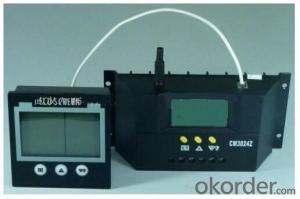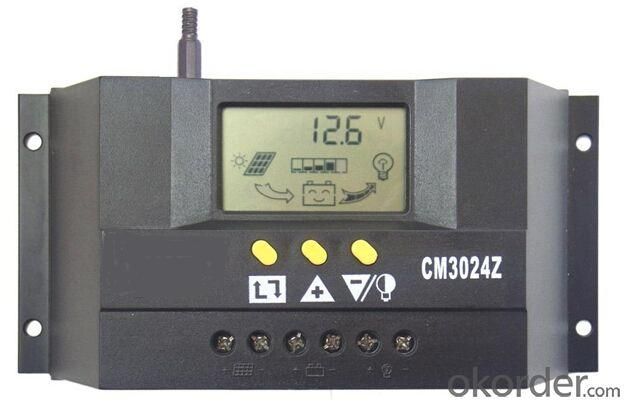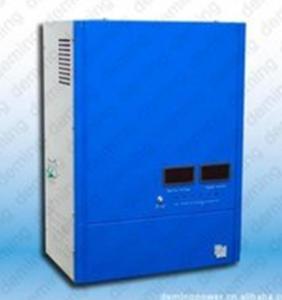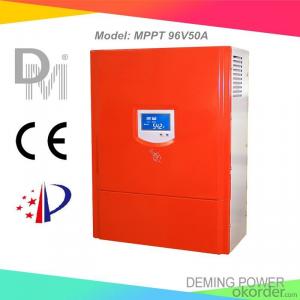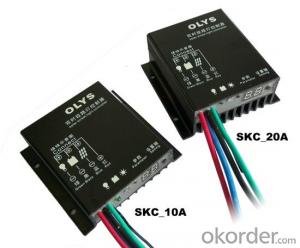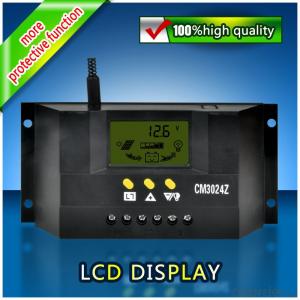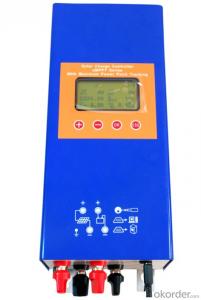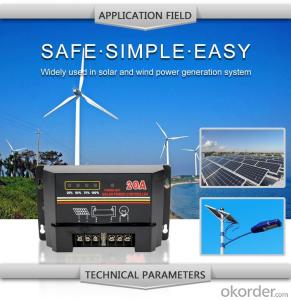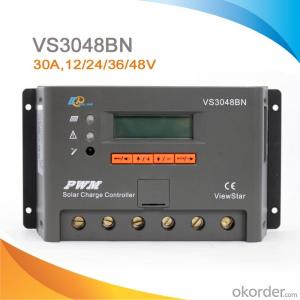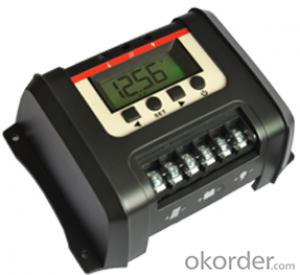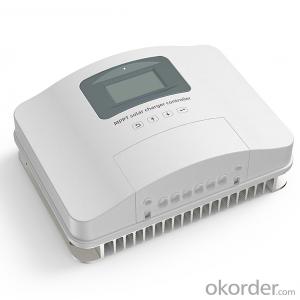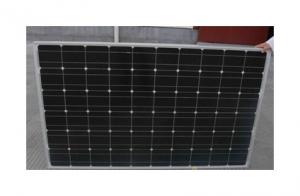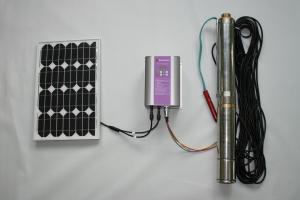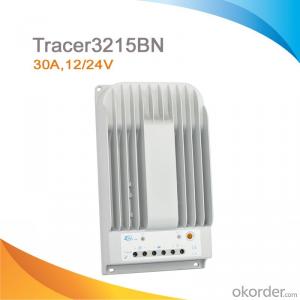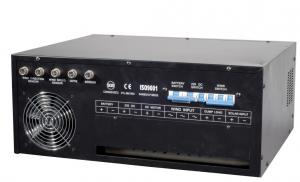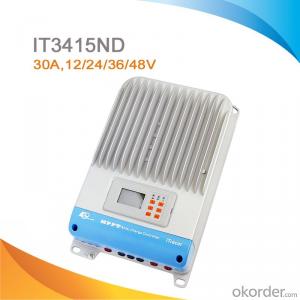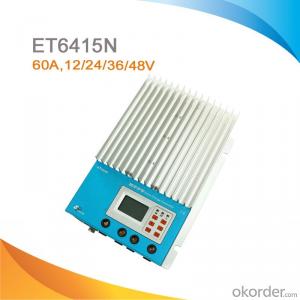Solar Powered Game Controllers with LCD Display Model CM 3024Z for Home Use
- Loading Port:
- Shanghai
- Payment Terms:
- TT OR LC
- Min Order Qty:
- 10 unit
- Supply Capability:
- 500 unit/month
OKorder Service Pledge
OKorder Financial Service
You Might Also Like
1. Structure of Solar Street Light Charging Controller for Home Use with LCD Display Model CM 3024Z
This solar street light charging controller is designed for home use, such as light in the yard. The controller of CM Series is a kind of intelligent and multi-functional solar charging and discharging controller. The products of this series consist of special LCD display which has very convenient operation interface, and all of the controls parameters can be set and adjusted according to different requirement. It is really a good example of solar energy application in daily use for home.
2. Main Features of Solar Street Light Charging Controller
· Vivid graphic symbol on LCD
· ·Easy and explicit operation with button
· ·Automatic identification of system voltage degree
· ·Intelligent charging mode of PWM
· ·Automatic temperature compensation
· ·Available for setting loading work mode
· ·Accumulative function for total Amper-hours during charging and discharging
· ·Reverse polarity protection and undervoltages protection for accumulator
· ·Overload protection and short circuit protection for accumulator
3. Solar Street Light Charging Controller Specification
Model | CM3024Z |
Rated working current | 20A \30A |
Rated working voltage | 12V/24V |
Solar panel voltage | ≤50V |
Floating charge voltage | 13.8V/27.6V |
Undervoltage protection | 10.7V/21.4V |
Undervoltage recovery | 12.5V/25.0V |
No-load loss | ≤30mA |
Circuit voltage drop | ≤170mV |
Charging mode | PWM MODE |
Temperature conpensation | -4mV/Cell/℃ |
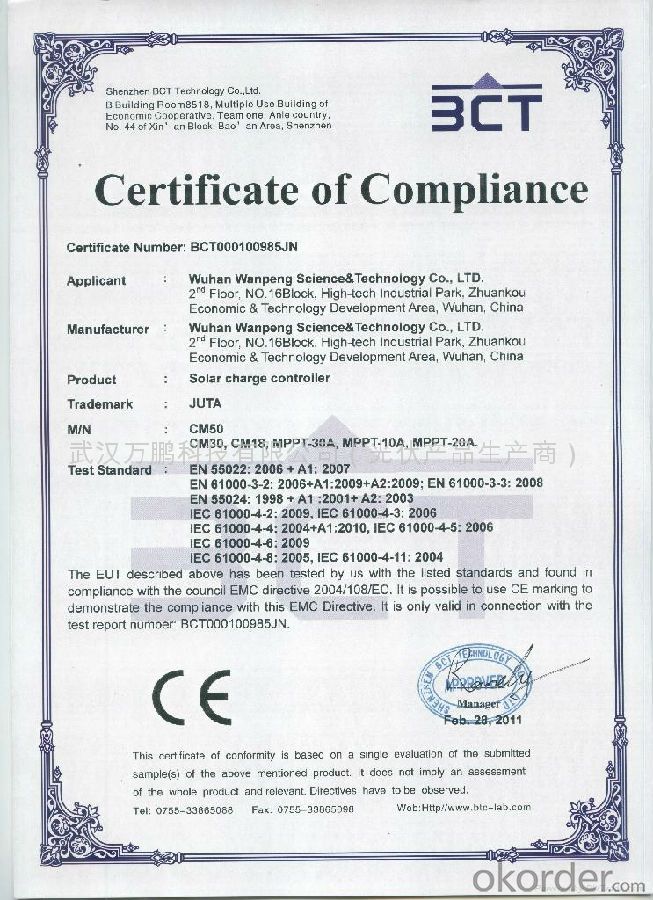
4. Solar Street Light Charging Controller Images
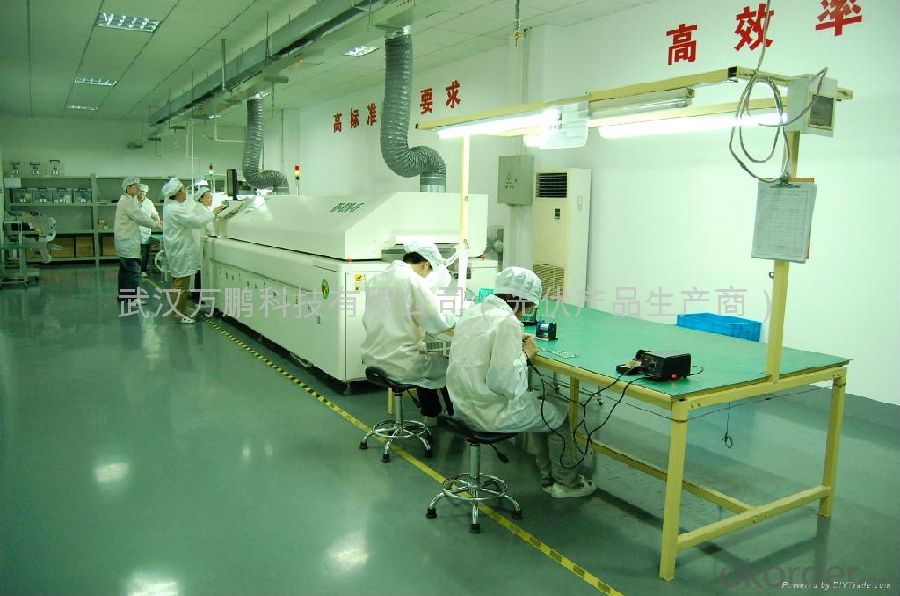
5. FAQ
We have organized several common questions for our clients, which may help you sincerely:
Q1. How to guarantee the quality of the products?
The company presses the ISO9000 quality management system control product quantity strictly, the export production all passes the relevant national company check (CE, ROHS), and get high evaluation of the customer.
Q2. How long can we receive the product after signing Sales Confirmation?
Generally speaking, if there is enough quantity of finished products which can meet the clients’ requirement, we can manage the delivery within three to five working days according to the instruction of the payment terms in the Sales Confirmation; if the products needs some time to get ready, we will arrange the delivery as soon as possible after the manufacture.
- Q: Can a solar controller be used with solar-powered indoor transportation systems?
- Yes, a solar controller can be used with solar-powered indoor transportation systems. A solar controller is responsible for regulating the flow of electricity from the solar panels to the battery or load, and it ensures that the battery is charged efficiently and protected from overcharging or discharging. In the case of solar-powered indoor transportation systems, the solar controller would play a crucial role in managing the power generated by the solar panels and delivering it to the propulsion system or other electrical components of the vehicle. By using a solar controller, the system can optimize the power conversion and utilization, maximize the efficiency of solar energy utilization, and ensure the longevity of the battery. Therefore, a solar controller is an essential component for integrating solar power into indoor transportation systems.
- Q: How does a solar controller handle battery temperature compensation?
- A solar controller handles battery temperature compensation by monitoring the temperature of the battery and adjusting the charging parameters accordingly. The controller uses sensors to measure the temperature and then adjusts the charging voltage and current levels to ensure optimal charging and prevent overcharging or undercharging of the battery. This helps to extend the battery's life and improve its overall performance.
- Q: What is the maximum number of solar panels a solar controller can handle?
- The maximum number of solar panels a solar controller can handle depends on the specific model and its specifications. Different solar controllers have different capacities, typically ranging from a few panels to several dozen panels. It is important to consult the manufacturer's guidelines or product specifications to determine the maximum number of solar panels that a particular solar controller can handle.
- Q: How does a solar controller handle temperature fluctuations?
- A solar controller handles temperature fluctuations by continuously monitoring the temperature of the solar panels or batteries and adjusting the charging parameters accordingly. It uses temperature sensors to detect changes in temperature and modifies the charging voltage or current to ensure optimal charging and prevent damage to the battery or panels. This helps to maximize the efficiency and lifespan of the solar system, even in varying temperature conditions.
- Q: What is the equalization charging mode of a solar controller?
- The equalization charging mode of a solar controller is a function that periodically applies a higher voltage to the battery bank to balance the charge levels of individual cells or batteries. This helps to prevent stratification and sulfation, ensuring the longevity and optimal performance of the battery bank.
- Q: Can a solar controller be used with a generator as a backup power source?
- Yes, a solar controller can be used with a generator as a backup power source. The solar controller regulates the charging and discharging of batteries in a solar power system, ensuring that the batteries are properly charged and protected. When a generator is used as a backup power source, the solar controller can still manage the charging process effectively, allowing for a smooth transition between solar power and generator power.
- Q: Can a solar controller be used in grid-tied systems?
- Yes, a solar controller can be used in grid-tied systems. Although grid-tied systems typically do not require a solar controller for battery charging or load control, it can still be utilized for various purposes. For instance, a solar controller can be employed to monitor the performance of the solar panels and regulate the output voltage and current to ensure optimal operation and integration with the grid. Additionally, it can protect the system from overcharging, overheating, and other electrical abnormalities. Therefore, while not essential, a solar controller can still be beneficial in grid-tied systems to enhance efficiency, reliability, and safety.
- Q: Can a solar controller be used with a solar-powered electric vehicle charging station for multiple vehicles?
- Yes, a solar controller can be used with a solar-powered electric vehicle charging station for multiple vehicles. The solar controller regulates and optimizes the power flow from the solar panels to the charging station, ensuring efficient and effective charging for multiple vehicles.
- Q: Can a solar controller be used with a battery bank that has different battery chemistries?
- No, a solar controller is not suitable for use with a battery bank that has different battery chemistries. Each battery chemistry has specific charging and discharging characteristics, and a solar controller is designed to work with a specific battery chemistry. Mixing different battery chemistries may result in inefficient charging, improper battery management, and potential damage to the batteries. It is important to use a solar controller that is compatible with the specific battery chemistry of the battery bank.
- Q: Solar controller can not charge what is the reason the electric power will be less than the inverter with no fixed freezer! Solar energy simply did not charge into the electricity
- Direct charge protection point voltage: direct charge also called emergency charge, are fast charge, are generally in the battery voltage is low when the use of high current and relatively high voltage on the battery charge, but there is a control point, also known as protection points, Is the value in the table above, when charging the battery terminal voltage higher than the protection value, should stop charging. Direct charge protection point voltage is generally "overcharge protection point" voltage, the battery voltage when charging the battery can not be higher than the protection point, otherwise it will cause overcharge, the battery is damaged
Send your message to us
Solar Powered Game Controllers with LCD Display Model CM 3024Z for Home Use
- Loading Port:
- Shanghai
- Payment Terms:
- TT OR LC
- Min Order Qty:
- 10 unit
- Supply Capability:
- 500 unit/month
OKorder Service Pledge
OKorder Financial Service
Similar products
Hot products
Hot Searches
Related keywords
